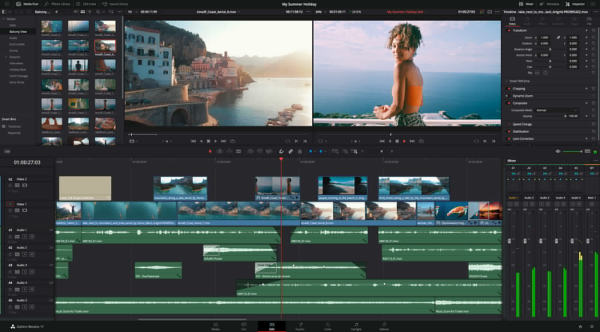After several beta releases, version 17.1 of Blackmagic's grading, editing, compositing and audio mastering program DaVinci Resolve 17 (Studio) for Windows, macOS and Linux is now final. This makes Resolve one of the first programs to support Apple's M1 processor and is now compatible with the new Big Sur version of the macOS operating system, which has also just been released.
Apple introduced the first new  versions of its MacBook Air, MacBook Pro notebooks as well as the Mac mini with the self-developed highly integrated M1 SoC in November last year, which distributes the CPU and GPU load more effectively through its unified memory architecture, making PCI Express transfers unnecessary.
versions of its MacBook Air, MacBook Pro notebooks as well as the Mac mini with the self-developed highly integrated M1 SoC in November last year, which distributes the CPU and GPU load more effectively through its unified memory architecture, making PCI Express transfers unnecessary.
The combination of M1 and Metal processing is said to offer up to five times improved performance in DaVinci Resolve 17.1 compared to previous generations of computers - here's our  review of DaVinci Resolve 17.1 Beta with Apple's M1 chip. In addition, Resolve 17.1 now supports decoding of H.265 4:2:2 video via M1 hardware.
review of DaVinci Resolve 17.1 Beta with Apple's M1 chip. In addition, Resolve 17.1 now supports decoding of H.265 4:2:2 video via M1 hardware.

But Windows users don't go empty-handed with the 17.1 update either - it brings hardware-accelerated encoding and decoding of H.265 10-bit 4:4:4 and 4:2:2 material with newer Intel processors (even in the free version of Resolve). It also brings GPU support for RED clips, a new insert option, and as always, general performance and stability improvements.
All the new features in DaVinci Resolve 17.1.
- Support for Apple Silicon based Mac OS systems.
- H.265 4:2:2 hardware decoding support on Apple Silicon.
- Support for H.265 4:2:2 and 4:4:4 Intel decoding in DaVinci Resolve Studio.
- H.265 4:2:2 and 4:4:4 Intel encoding support in DaVinci Resolve Studio.
- GPU decoding support for RED clips in OpenCL processing mode.
- Option to always perform copy and paste actions on selected color nodes.
- General performance and stability improvements.

